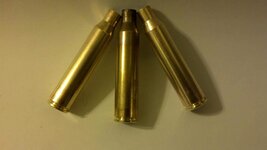Bronze Lifetime
- Messages
- 11,314
- Reactions
- 25,928
Bought a 2.5 liter ultrasonic cleaner at Harbor Freight with a timer and tank heater. Finally pulled it out today.
Used 1 quart tap water, 1 quart distilled white vinegar ($3.08/gallon @ Winco), 1 tsp Cream of Tartar (~10¢) and three shakes of "Barkeeper's Friend", which is Oxalic acid (~2¢).
Did 100 cases of 338 Lapua Mag and 200 cases of 7mm Rem Mag in under 35 minutes. What I _really_ liked is how clean the INSIDE of the cases got. When I finished, the water was black.
Here's what the Lapua Mags looked like. Two clean ones on the outside, a dirty one on the inside. The photo may not do it justice, but there's a huge difference in my eyes between the dirty and clean ones.


Used 1 quart tap water, 1 quart distilled white vinegar ($3.08/gallon @ Winco), 1 tsp Cream of Tartar (~10¢) and three shakes of "Barkeeper's Friend", which is Oxalic acid (~2¢).
Did 100 cases of 338 Lapua Mag and 200 cases of 7mm Rem Mag in under 35 minutes. What I _really_ liked is how clean the INSIDE of the cases got. When I finished, the water was black.
Here's what the Lapua Mags looked like. Two clean ones on the outside, a dirty one on the inside. The photo may not do it justice, but there's a huge difference in my eyes between the dirty and clean ones.













